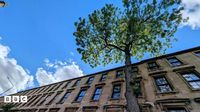On a bustling street in the heart of Glasgow, an ash tree has quietly stood witness to generations of city life, long before it became the talk of the nation. Now, that very tree—known as the Argyle Street Ash—has been crowned the Woodland Trust’s Tree of the Year 2025, capturing the imagination and affection of not only Glaswegians but people across the UK.
The announcement came on September 25, 2025, after several weeks of public voting, marking the second consecutive year that a Scottish tree has clinched the prestigious title. But the Argyle Street Ash’s win wasn’t a foregone conclusion. In fact, it wasn’t even on the original expert shortlist of nine trees. Instead, it was nominated as a wildcard entry by David Treanor, a Glasgow arborist who’s managed the tree for the past five years. Treanor’s advocacy and the tree’s deep ties to the local community propelled it to the top, beating out some stiff competition—including the ancient King of Limbs Oak in Wiltshire and the picturesque Lonely Tree on the edge of Llyn Padarn in North Wales.
“There are stories of people’s mothers and fathers meeting underneath the tree, there are people who hail taxis and ask it to be sent to the big tree on Argyle Street—there are so many lovely wee stories about it,” Treanor told BBC Scotland News. “It was the people’s tree, the only urban tree on the shortlist, and people in Glasgow got behind it.”
This year’s contest theme, “rooted in culture,” was chosen to highlight how trees shape our cultural landscapes—whether in literature, music, poetry, or art. The Argyle Street Ash certainly fits the bill. It’s referenced in James Cowan’s 1951 book Glasgow’s Treasure Chest, where Cowan describes it as “quite the most graceful ash I have seen.” That quote now hangs in a frame on the wall of the pub opposite the tree, a venue known for its regular Gaelic live music events. The tree’s presence, it seems, is woven into the very fabric of the neighborhood.
At approximately 75 feet tall and around 175 years old, the Argyle Street Ash is no ancient monolith like some of its rivals. What it lacks in age or dramatic scenery, it more than makes up for in resilience and community connection. According to Treanor, the tree is part of Glasgow’s “emotional architecture,” having survived redevelopment, the Clydeside Blitz during World War II, the rise and fall of Victorian industry, and even the threat of ash dieback—a disease decimating ash populations across Europe.
Anna Perks, tree equity lead at the Woodland Trust, remarked on the outpouring of support the tree received. “It had been a delight to see the human connection to the tree be shown during the voting,” she said, noting how the Argyle Street Ash is deeply tied to the stories and daily rhythms of those living nearby.
Adam Cormack, head of campaigning at the Woodland Trust, echoed these sentiments. “Trees really matter to people, and this is clear from the response we’ve seen to the Argyle Street Ash. Trees inspire us to write stories and create art, whilst connecting us to cultural legacies and a sense of place,” he told BBC. “We encourage people to notice and enjoy the trees around them, and learn more about how they benefit us—from boosting biodiversity and wellbeing, to mitigating the effects of climate change.”
Competition was fierce. The Argyle Street Ash narrowly edged out the King of Limbs Oak, an ancient tree in Wiltshire thought to be at least 1,000 years old and the inspiration for a Radiohead album. The Lonely Tree, a solitary birch standing against the imposing backdrop of a lake and mountains in Llanberis, Wales, also made a strong showing. Rounding out the top five were the Lady Jane Grey Oak in Leicester’s Bradgate Park—rumored to have inspired Virginia Woolf—and a majestic cedar at London’s Chiswick House, where The Beatles were famously photographed.
Laura Chow, head of charities at People’s Postcode Lottery, which supported the competition, called the Argyle Street Ash “a worthy winner.” She emphasized the broader significance of the event, saying, “These trees, rooted in culture, show how valued they are by their communities, and the significant importance they have in our wider cultural history. What a worthy winner the Argyle Street Ash is.”
The contest, now in its second year with a Scottish winner, has previously celebrated a sweet chestnut in Wrexham’s Acton Park, an ancient yew at Waverley Abbey, Liverpool’s Allerton Oak, and Nellie’s Tree—also known as the Love Tree—in West Yorkshire. Last year’s winner, the Skipinnish Oak in Lochaber, set a high bar for community engagement, but the Argyle Street Ash’s victory demonstrates the unique role urban trees can play in city life.
Treanor hopes the recognition will spark a broader appreciation for urban trees everywhere. “I hope this is a victory for misunderstood urban trees all over the world,” he said, expressing his wish that other cities will be inspired to protect and celebrate their own green landmarks.
The Argyle Street Ash’s journey isn’t over yet. As the winner of the UK competition, it will go on to represent the country in the European Tree of the Year finals in early 2026. The spotlight may be new, but for the people of Glasgow, the tree’s significance is old news—a steadfast companion through decades of change, celebration, and everyday life.
As Adam Cormack put it, trees are more than just part of the landscape; they’re part of our stories, our art, and our sense of home. For the Argyle Street Ash, those roots run deep—right through the heart of Glasgow.


